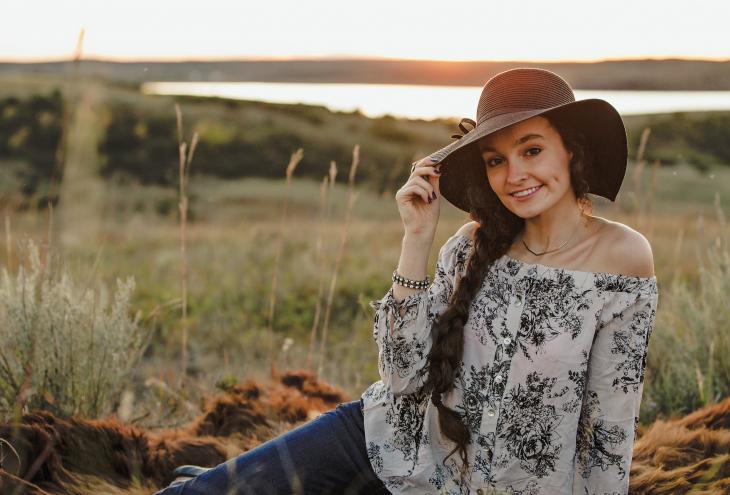Elsie DuBray turns 18 on the Fourth of July. She’s headed for Stanford University after graduating last spring from Timber Lake High School in Timber Lake, S.D., where she sang in the choir, played flute in the band, participated in the One-Act Play and Oral Interpretation programs, served as student council president, played volleyball, and volunteered with the Cheyenne River Youth Project.
She managed to keep track of that busy schedule while living in two different time zones. “My house goes by central time,” she says. “My school goes by mountain time.” DuBray stopped wearing makeup, she laughs, to save a little more time getting ready for school. But she would always steal a few of those hectic morning minutes to watch the bison grazing as they made their way across her family’s land, where the Missouri and Moreau Rivers meet. “It’s really beautiful,” she says. “That’s something I will always feel very grateful for. The calves are so adorable — add snow to that picture and it’s like a postcard.”
DuBray and her father, Fred, would eat and talk while her mom, Michelle, helped pack her lunch before she had to make the 60-mile drive to school with her 16-year-old brother, Beau, who will be a junior in the fall. Growing up, Elsie had a lot of questions, and her family encouraged her to ask them. “I’ve always been a curious person,” she says, “and I think really liking science comes from that.”
But it wasn’t until her sophomore year that DuBray finally entered a science fair. She says her first project for the High Plains Regional Science and Engineering Fair (HPRSEF) was “really embarrassing” because it was simplistic. “I looked into what effect the flavor of gum we chew has on the amount of bacteria in our mouths.” But that “embarrassing” project earned DuBray a spot as an observer at the prestigious Intel International Science and Engineering Fair (ISEF) in Los Angeles, where she saw projects that inspired her. “Students from 78 countries were tackling huge issues facing the world,” she recalls. “I felt like I belonged — I was with people who cared like I did. And I was determined to come back as a competitor.”
DuBray had only to look out her kitchen window to find a project that would let her do just that. In addition to earning the distinction of Overall Winner of HPRSEF, her new project merited a finalist spot at the 2017 ISEF, where she placed third in biological sciences. She also placed first with her poster research presentation at the 2017 AISES National Conference in Denver. In 2018 her ongoing research again earned her the Overall Winner recognition at HPRSEF and another chance to compete as a finalist at ISEF, where she placed fourth in biological sciences.
Perhaps not surprisingly, DuBray’s winning project focuses on bison. “That’s what my family consumes, what my family believes in, what my family does,” she says. “I analyzed the lipid content in grain-fed and grass-fed buffalo and beef in search of a correlation between the switch from a traditional diet and the Native American diabetes epidemic.”
Her research focuses on the fat in the four different types of meat. “I extracted the fat, performed infrared spectroscopy, and recently performed thin-layer chromatography,” she explains. “I’m trying to identify and quantify the different, specific compounds — both healthy and unhealthy — in the fat. I’m looking for saturated and unsaturated triglycerides, and I’m excited to isolate unsaturated fatty acids like omega-3 and conjugated linoleic acids, as these are well-known for their many health benefits.”
DuBray is eager to show how the change in traditional diets to the European-introduced beef has been devastating to American Indians. “The results have been promising,” she says.
DuBray is eager to show how the change in traditional diets to the European-introduced beef has been devastating to American Indians.
“You can clearly see distinguishable links between the healthy fats in buffalo meat and the unhealthy amounts in beef fat. I plan on continuing my research in college.” Why does she care so much about this topic? “Our people are not healthy right now. The statistics are devastating,” she explains, citing the rise of diabetes. You won’t find fry bread in the DuBray household. “I eat it at functions,” she admits, explaining that she tries to talk about traditional foods and traditional diets with her peers, but they inevitably bring up fry bread. Yet, she says, “Native people are resilient — that’s why we’re still here against all odds.”
DuBray is not diabetic, but she knows she’s genetically predisposed to the disease. “I want to be a scientist,” she says. She’s interested in biochemistry, but that major isn’t offered to undergrads at Stanford, so she’s considering a major in biology. “I would also like to major in Native American studies,” she adds, “because it complements the science.”
DuBray says she wants to prove the validity of traditional knowledge and can see herself working as a research scientist or nutritionist. And she’s already helping to spread the word about the importance of nutrition. She will be featured in Gather, an upcoming documentary about the significance of a traditional diet and the food sovereignty movement sweeping the country. “I feel lucky to have found something I’m that passionate about,” she says.













